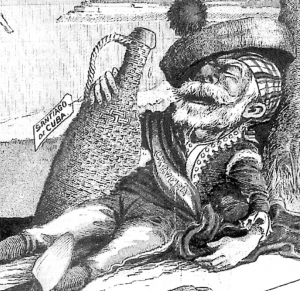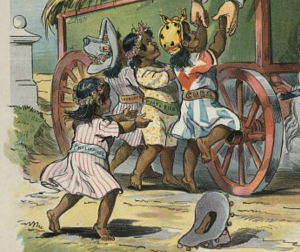While political cartoons can be very useful to investigators as they make sense of the historical context in which they were created, they must exercise caution when approaching them as historical evidence.
Why can they be so difficult to interpret? The key to working with political cartoons is becoming aware of cartoonists’ intentions for creating these illustrations and the persuasive techniques employed by them to get their point across. Once researchers become cognizant of cartoonists’ political positions or biases and spot their rhetorical techniques, they will be able to figure out the messages being conveyed by these cartoons. This is also true for persuasive techniques used in current media, such as political memes and ads. It is always a good idea to understand what is behind these modern visual representations and what they want to persuade the public to believe.
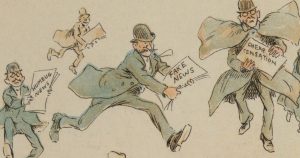
Political cartoons, which would typically appear, not in the comics section, but in editorials, became an important medium for shaping public opinion on current affairs. With one quick glance, they have the power to promote political views and perceptions of individuals and groups, leaving a strong impression on the audience. Researchers must keep in mind the fact that cartoonists oftentimes manipulated images to convey a convincing editorial message to audiences, a message that may not even reflect the cartoonist’s viewpoint. Some questions to pose as you examine these visual representations:
- What is the opinion being conveyed by the cartoon?
- Does the cartoon message reinforce the opinion of what’s written in the editorial?
- What reaction do you think the cartoon generated among the audiences of the time?
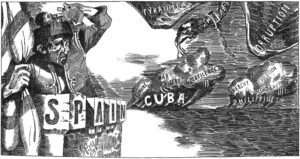
Another aspect that makes interpretation of cartoons difficult is having to make sense of a representation comprised of a graphical and textual elements. What has started as genre of word balloons, had quickly evolved into more complex illustrations accompanied by textual messages. Text that appears on a cartoon comes in two basic forms: words attributed to cartoon characters or objects, and captions added by the artist. Captions can be placed anywhere in the cartoon area and they can be used to explain, comment on, or reveal the cartoon message.
- What is the relationship between the text and the illustration?
- Are the captions contradicting or supporting the cultural meanings produced by the illustration? How so?
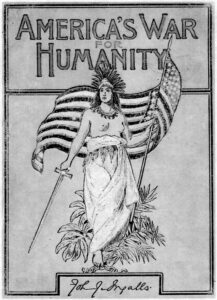
Interpreting cartoons involves a different type of “reading” as they may appear as ambiguous. This is especially true back in the 1890s, as cartoonists brought the skillful element of satire to their creations. They often alluded to elements and imagery from the classics, such as ancient mythology, the Bible, and classical literature. Drawing inspiration from the classical traditions allow them to make incidental funny points about their socio-political situation. The imperialist construct of “civilization” versus “barbarism” is one example of the rhetoric that was reinforced by many of these American political cartoons. Allusions to antiquity made it possible for cartoonists to draw an image that would capture the depth of an issue, whether that issue was immigration, labor, poverty, religion, race, or citizenship. Some questions to pose when working with cartoons:
- What is the main point of the cartoon?
- What is the topic covered?
- What imagery from the classic tradition is the cartoonist incorporating to make that point?
- Is the message pro-imperialist or anti-imperialist?
- What are these elements poking fun at?
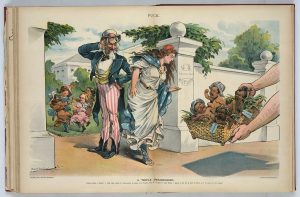
Political cartoonists have always used a set of techniques to persuade audiences to their own (or their editorial) point of view on current affairs. There are five main persuasive techniques typically employed by these artists: symbolism, analogy, irony, exaggeration, and labeling.
Symbolism
Political cartoons are known for including elements that stand for other things, people, ideas, or events. The symbolic figure of Uncle Sam (initials U.S.), for instance, is one that personifies the U.S. government. Another good example of symbolism is the female figure of Columbia, which was often used by cartoonist to represent a maternal version of the American nation, reaching out to the oppressed and reminding Uncle Sam to step in as the moral crusader and father of newly acquired “children” (Hawaii, the Philippines, Cuba, Puerto Rico, and other territories).
Analogy
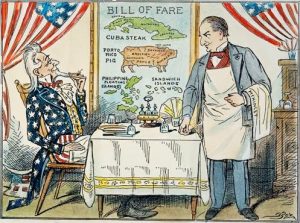 Analogy is about comparing complex concepts of issues to demonstrate only one. Cartoonists resort to this technique to help readers see a political situation by comparing it with a more familiar one. It could also be about objects representing or used by characters. The cartoon “Well, I hardly know which to take first!”, Uncle Same is seated in a restaurant, looking at the bill of fare containing “Cuba steak”, “Porto Rico pig”, and talking to waiter “McKinley”. The bill of fare is analogous to the acquisition or possession of the new territories.
Analogy is about comparing complex concepts of issues to demonstrate only one. Cartoonists resort to this technique to help readers see a political situation by comparing it with a more familiar one. It could also be about objects representing or used by characters. The cartoon “Well, I hardly know which to take first!”, Uncle Same is seated in a restaurant, looking at the bill of fare containing “Cuba steak”, “Porto Rico pig”, and talking to waiter “McKinley”. The bill of fare is analogous to the acquisition or possession of the new territories.
Irony
Irony is the difference between the way things seem to be and the way things really are beneath the surface. The message presented at the surface is contrasted by the underlying meaning. Political cartoons tend to rely on irony to express their opinions on the issue.
Exaggeration
Exaggeration is representing something or someone as more extreme that it really is in order to make a point. It typically involves magnifying, maximizing, overdoing, or overblowing personal traits, ideas, objects, or events to the point of being ridiculed. This technique is quite impactful as it draws attention and generates a visceral reactions from viewers.
Labeling
Labeling is the identification of objects, people, or events, through the use of labels. They often help the cartoonist convey a point in more clear ways.
Questions you may pose when studying a cartoon:
- What are the key symbols in this cartoon and how are they distorted?
- What are these symbolic distorted elements representing? Are they standing for a person, a population, an event, an abstract idea?
- How are these symbols drawn?
- What is the cartoon’s main analogy? What is the analogy between?
- What is the political situation it is being compared with?
- Why did the cartoonist choose to label that object or person?
- How does the label help the cartoonist? Does it make the cartoon meaning more clear?
- What is the meaning conveyed by the cartoonist?
- What persuasive techniques are employed to shape my opinion on a topic?
